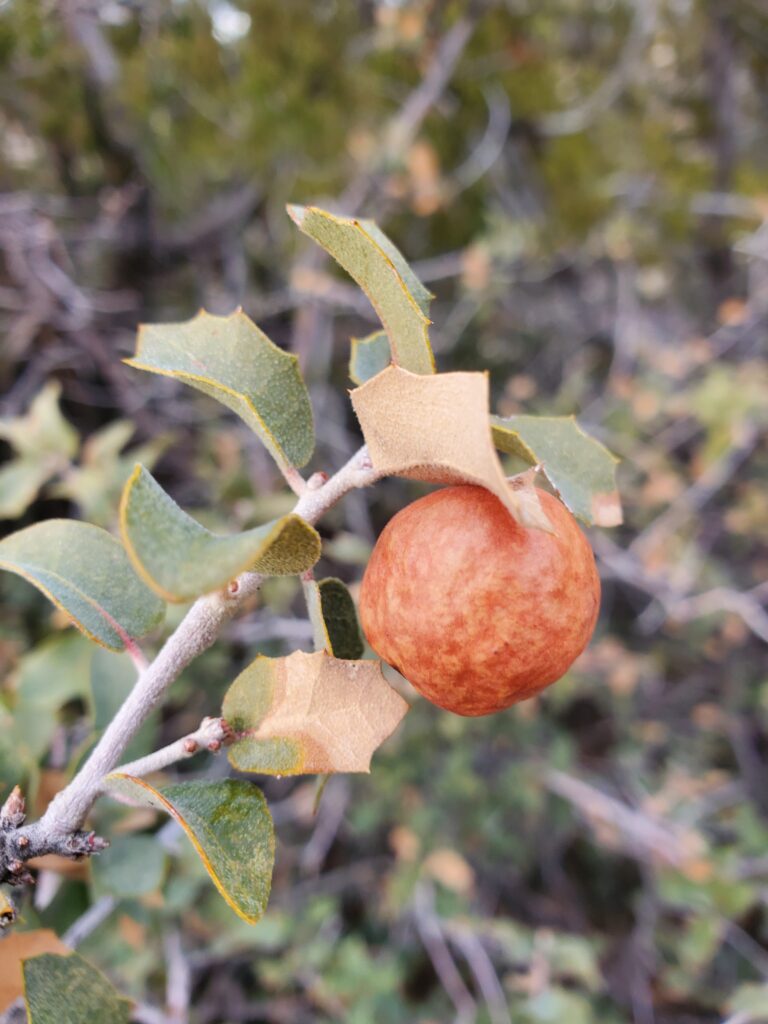By Quin Baine, PhD candidate at the University of New Mexico

If you’ve ever seen an unusual looking growth on a plant, like a furry-looking lump on a leaf, or a swollen stem section, you probably saw what is known as a plant gall! Galls are abnormal growths of tissue on plants that instead of being caused by an injury or mutation, like burls and cankers, are caused by the development strategy of another organism. Fungus, bacteria, viruses and nematodes can be simple gall inducers on plants, creating galls that are tumor-like proliferations of cells. However, most galls you can encounter are induced by insects and mites. Insect induced galls are intricate, and often visually striking, structures of differentiated cell types that serve as home to the insect’s developing offspring.
When a galling insect lays its egg into plant tissue, and that hatched offspring begins to feed on the plant, a complex chemical and hormonal interaction takes place to induce the growth of nutritious cells on which the growing offspring can feed. Also induced in this process are cells that make up the protective exterior of the gall; these surfaces can be woody, spiky, hairy, sticky, etc. One of the weirdest things about galls is that they are mysterious! Though we have some research findings connecting galls to the insect’s salivary gland secretions, or maternal venom secretions, how this manipulative interaction works remains mostly unknown on a cellular level and molecular level.
Insects that produce galls are a type of plant pest, because they are hijacking plant resources, like nutrients and water, to grow. However, they often don’t cause any damage to the plant, and only in very few cases do they interfere with plant reproduction. Galls can be rare, or extremely abundant, and the patterns behind these variable distributions and densities are unknown. If you see galls on plants at your home, it is highly recommended you try to identify the inducer before trying to remove them – in most cases, particularly where plentiful resources are available to the plant, both can co-exist happily.
One of the coolest things about insect galls is that they occur on a huge variety of plants. In temperate regions, the plant groups that most commonly have galls are oaks, roses, asters (composites), and willows. However, galls are recorded from such surprisingly diverse plants as grasses, sedges, ferns, cactuses, aloes, orchids, solanum, bromeliads, sedums, cycads, and horsetails. Gall inducing insects are almost always specific to particular plants, so if you can identify the plant, you can easily identify the insect gall using a guidebook (Plant Galls of the Western United States, Russo 2021) and internet resources (gallformers.org, inaturalist.org).
There are many galls that likely occur in City of Rocks State Park based on the known vegetation in the region. Galls induced by midges, a small mosquito-like fly, are the most diverse, and often most frequently encountered. Lasioptera ephedrae induces a common, yet subtle stem swell gall on Mormon Tea. A few species of cryptic midges, including Asteromyia gutierreziae which makes a thin, black stem gall, occur on Snakeweed. Several undescribed midge species make galls on the buds or leaf tips of Junipers in the Southwest. The midge genus Asphondylia is very common in New Mexico, and many species can be found on Four-wing Saltbush. This includes Asphondylia neomexicana, which induces a large, round, cotton ball looking gall that are usually clustered on the stems of the plants. Creosote also hosts a diverse array of Asphondylia midges, that are all shapes and sizes and can be sticky and/or fuzzy. One of the most easily spotted is Asphondylia auripila because it is a large (~ 2 inches in diameter) gall that resembles a dense clump of vegetation on the stem tips.
As well as midges, Rubber Rabbitbrush is host to a suite of gall-inducing “picture wing” flies. This includes the cotton-gall tephritid (Aciurina bigeloviae) and the bubble-gall tephritid (Aciurina trixa), which both create spherical galls that are easy to see where they occur. One reason for this is that the full-sized galls are present all winter, so even after the leaves fall off the plant, the galls cover the plant like small ornaments on a Christmas tree. Mule Fat (Baccharis) and Little Leaf Sumac are host to Eriophyidae mite galls, which often appear as lumpy pimple-like, and often bright red structures along the leaves.
Oaks are the most common host of Cynipoidea wasp galls which can be found in maturity in late summer and early fall. Gray, Arizona, and Scrub Oak are host to some of the easiest to find wasp galls in New Mexico due to their bright colors and unique textures. Atrusca galls develop on the leaves, and are called “oak apples” because they are large (~ 1-3 inches in diameter), spherical and red or pink in color. Feron tetyanae leaf galls appear furry, like a caterpillar, and are sometimes hot pink! Oak galls are also known to host some of the most fascinating communities of associated insects; for example Disholcaspis “bullet” galls on the stems are recorded to secrete a sugary substance that attracts ants. In return, the ants protect the galls from other predators.
Plant galls are fascinating things to look for in New Mexico. They are the product of a completely unique symbiotic process not mirrored elsewhere in nature, extremely diverse, associated with many undescribed insects, and are easy to identify based on the plant association. Once you know about them, and how common they are, it’s easy to start seeing galls almost anywhere you go to look for plant life. Simply take a look around on your next hike, and you can start to see and appreciate these special interactions.